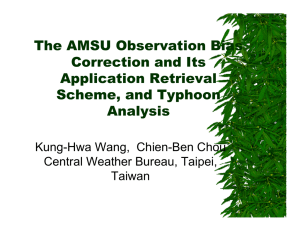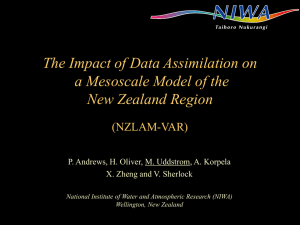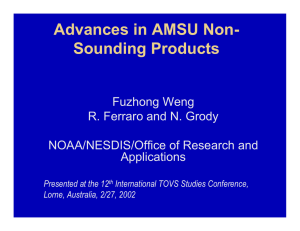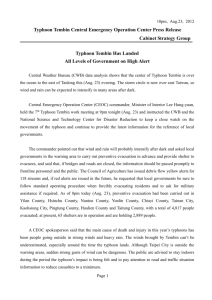Th e AMSU Observation Bias Correction and Its Application
advertisement
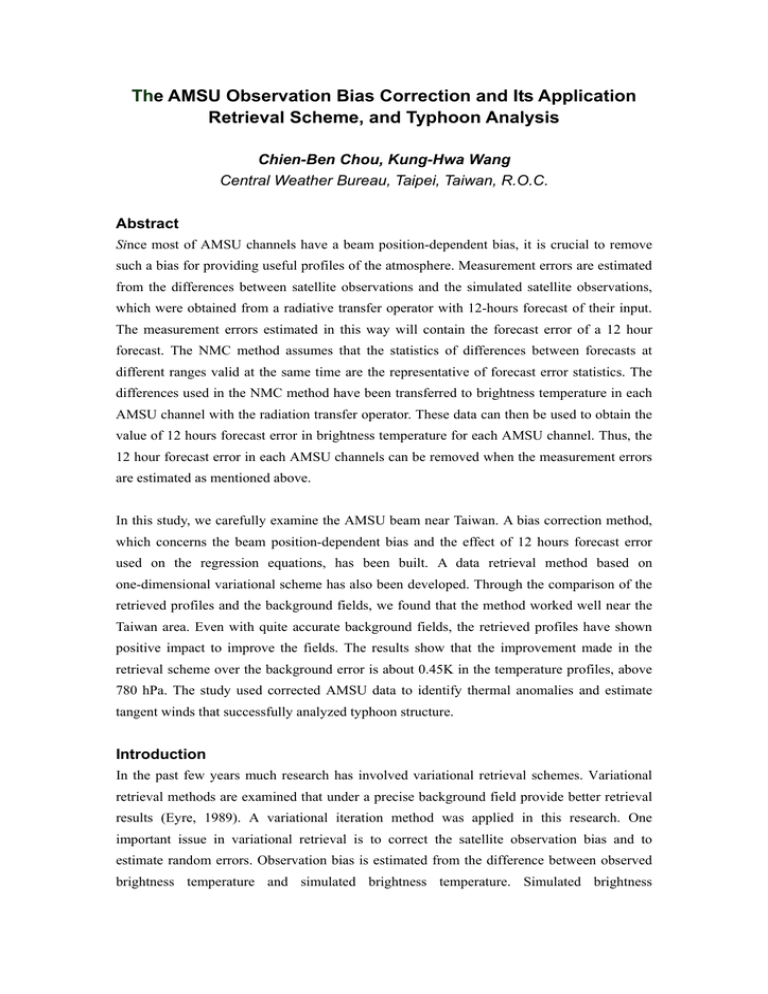
The AMSU Observation Bias Correction and Its Application
Retrieval Scheme, and Typhoon Analysis
Chien-Ben Chou, Kung-Hwa Wang
Central Weather Bureau, Taipei, Taiwan, R.O.C.
Abstract
Since most of AMSU channels have a beam position-dependent bias, it is crucial to remove
such a bias for providing useful profiles of the atmosphere. Measurement errors are estimated
from the differences between satellite observations and the simulated satellite observations,
which were obtained from a radiative transfer operator with 12-hours forecast of their input.
The measurement errors estimated in this way will contain the forecast error of a 12 hour
forecast. The NMC method assumes that the statistics of differences between forecasts at
different ranges valid at the same time are the representative of forecast error statistics. The
differences used in the NMC method have been transferred to brightness temperature in each
AMSU channel with the radiation transfer operator. These data can then be used to obtain the
value of 12 hours forecast error in brightness temperature for each AMSU channel. Thus, the
12 hour forecast error in each AMSU channels can be removed when the measurement errors
are estimated as mentioned above.
In this study, we carefully examine the AMSU beam near Taiwan. A bias correction method,
which concerns the beam position-dependent bias and the effect of 12 hours forecast error
used on the regression equations, has been built. A data retrieval method based on
one-dimensional variational scheme has also been developed. Through the comparison of the
retrieved profiles and the background fields, we found that the method worked well near the
Taiwan area. Even with quite accurate background fields, the retrieved profiles have shown
positive impact to improve the fields. The results show that the improvement made in the
retrieval scheme over the background error is about 0.45K in the temperature profiles, above
780 hPa. The study used corrected AMSU data to identify thermal anomalies and estimate
tangent winds that successfully analyzed typhoon structure.
Introduction
In the past few years much research has involved variational retrieval schemes. Variational
retrieval methods are examined that under a precise background field provide better retrieval
results (Eyre, 1989). A variational iteration method was applied in this research. One
important issue in variational retrieval is to correct the satellite observation bias and to
estimate random errors. Observation bias is estimated from the difference between observed
brightness temperature and simulated brightness temperature. Simulated brightness
temperature is calculated based on a forecast model through a RTE model. So the observation
bias is included in the numerical forecast model’s error. In order to make the data correct for
retrieval, a statistical correct scheme is needed.
Variational Methodology
The solution of the variational retrieval scheme is to get the minimum value of the cost
function. Then it gets the best atmosphere parameter: x. The cost function is written as
follows.
(
)
(
) {
{
}
J ( x ) = x − x b C −1 x − x b + y m − y ( x)} E −1 y m − y ( x)
T
T
(1)
x b is background (or initial guess). C is covariance of background error. y m is observation
values. y (x) is simulation values from RTE while atmosphere parameters are x.
The cost function is the sum of the deviation between x and the background and the deviation
between the observed value and calculated value under x situation. So we should find a proper
x that lets the calculated value correspond to the observation value relevantly. The
methodology is using Newtonian iteration method(Eyre 1989).
{
}
x n +1 = x b + Wn y m − y ( x n ) − K n ( x b − x n )
(2)
Wn = CK nT ( K n CK nT + E ) −1
When the value x n +1 − x n is smaller than a threshold, then above function converges.
The covariance error of the background field may be obtained by statistical calculation from
the error of 12 hour forecast field (Parrish and Derber 1992). Errors of other parameters are
set as follows, surface air temperature is 2.34K, surface air humidity is 0.3 ln(g/kg), surface
temperature is 1.67K, surface pressure is 3.42hPa, the content of ozone is 40 Dobson, cloud
height is 200hPa, cloud fraction is 0.5 and cloud liquid water content is 0.5mm. (Eyre 1990).
Surface emissivity is described as in (Grody 1988)
ε (ν ) =
εν + ε x (ν / ν 0 ) k
1 + (ν / ν 0 ) k
(3)
During the retrieval procedure the corrected magnitude of background error depends on the
ratio of observation error and background error, which is presented by matrix E and matrix C.
The calculation of the observation covariance error is a little complicated. The estimated
satellite observation error includes instrument error, satellite data procedure error, radiation
transfer model error and error of radiation model input parameters. In summary, above items
could be classified into two items, that is systematic error and random error. Systematic error
is possiblely corrected. Random error is the diagonal elements in matrix E. Because the limb
effect of AMSU is asymmetrical, limb adjustment procedure is also necessary.
AMSU Bias Correct and retrieval result
The merit of variational retrieval can be applied directly to satellite observation data; it may
avoid some errors which were caused during preprocessing (Eyre 1989). AMSU limb effects
along the viewing angle are due to asymmetry, we must adjust for this. First, we plot the
scatter diagrams of AMSU for each channel to each FOV. Before doing the adjustment, the
difference between observation data and calculated data are chosen. This data should be
estimated for its mean and standard deviation. If any channel differences between observation
and calculated are larger than 3 times of the standard deviation, these data are treated as bad
data. Channel 7, for four different scan angles, are shown in Fig. 1.
Fig.1: Scattering diagram of AMSU channel 7 for simulated Tb and measured Tb from
FOV of 1 to 4. The scan angle biases are a little difference.
After proper data are selected, regression coefficients are calculated for each channel in
each viewing angle to correct the observation. Then adjusted brightness T * = aTB + b will
be found, where TB is the observed satellite brightness temperature, a is slope and b is
intercept.
About 900,000 data were used to get these coefficients. Because estimated observation
systematic error and random error are included in the background (forecast) error, the 12
hours forecast statistic error has been transferred to radiance. Then the background error can
be removed. AMSU channel 2 is used as a parameter to adjust surface emissivity, this
adjustment will be done when calculated Tb are equivalence to observed Tb. In reality it is not
a proper procedure, but it is more reasonable when no observations of surface emissivity exist.
Real data on 22 June 2002 were tested, and the improvement of vertical temperature is
significant, as shown on Fig. 2.
Figure 2. Real data on 22/Jun/2002 23Z. Total 927 corrected satellite observation were
retrieved. (a)temperature (b)maxing ratio mean error covariance. Solid line is background
error and dash line is error of retrieval.
Limb Adjustment on AMSU
For the asymmetry of AMSU limb bias, statistical methods were considered. We tried to
use the algorithm from Goldberg(2001). Because of misinterpretation of the physical
coefficient, some channels of AMSU were not corrected. The results are shown on Fig 3.
Surface channel 1,2 are correct, but others channels are failed to be correct. Further
investigation is needed.
Typhoon Monitoring - methodology
Understanding the thermal structure of typhoons is helpful to weather forecasting. It has
been examined that a relationship exists between temperature anomalies and the maximum
wind and central pressure of tropical cyclones.(Kidder 2000)
correction to each FOV before
Whether to make a limb
NOAA16_20030630_0416_14273
Comparison for Limb Correction
280
360
240
320
A4
A1
200
280
A3
240
160
A2
200
120
270
0
10
260
20
30
235
0
10
20
30
20
30
230
A5
A7
225
250
240
220
A6
A8
230
215
220
210
228
0
10
20
A10
10
250
A13
240
216
230
212
A12
A9
208
0
260
224
220
30
270
220
30
0
10
20
0
10
20
30
Figure 3. AMSU limb adjustment results for NOAA 16 channel 1-13. Dash line means raw
data, red solid line means applied by NESDIS coefficients, blue line means results in this
study.
retrieval or make a different set of coefficients for each FOV is a controversial problem. Zhu
and Kidder (2002) show that the RMS error is less than 1.75K for the above two schemes. So
here, the latter scheme was chosen for further processing.
AMSU has the capability to penetrate cloud, but the AMSU observation still can be
interfered by raindrops. It may cause the temperature too cool under 700hPa in retrieval
temperature profiles near the typhoon center. So under heavy rainfall situation channel 3-5 are
not recommended be use in retrieval. Only channesl 6-11 were used to retrieve temperature
profile. When temperature profiles are retrieved from AMSU, the 2 or 3 dimension gradient
wind vectors can be estimated using the gradient balance equation. The algorithm to estimate
the 2-dimension gradient wind is from the paper of Kidder (2000). In order to study the center
of a typhoon, the 250hPa highest temperature anomaly is located. The method used to drive
the 3-dimension wind vector has been described in Zhu etal. (2002).
Typhoon Monitoring - result.
The above techniques was applied on the typhoon of 16/Oct/2001 23Z. As shown in Fig 4,
AMSU channels 6-11 of NOAA-15 was used for the case study. The anomaly of temperature
near the center of the typhoon is obviously identified. Anomaly warming extends from level
250hPa with anomaly of 7K to level 620hPa with a 4K anomaly. The warm core is a little
inclined to the north. The gradient wind is changing with the radius of typhoon and pressure
variance as shown in Fig 5. Maximum wind speed is located at a radius about 100km. Mean
maximum wind speed is about 25m/s. From the pattern of the wind fields, positive vorticity
exists in the lower layer of the typhoon. Weak negative vorticity is located on upper layers of
the typhoon. The structure of the typhoon is reasonable, given general acknowledge. The core
of maximum wind speed inclines to the outside, this is characteristic of a strong typhoon.
According to the empirical function (Kidder 2000) , the temperature anomaly is used to
estimate the maximum wind speed and radius of maximum wind speed. This typhoon has a
maximum temperature anomaly of about 10.5K, so the maximum wind speed should be
46m/s, and radius of maximum wind speed is 125Km. From Fig. 5 mean maximum wind
speed is about 25m/s, which is the value of the mean azimuth angle. So the estimated wind
speed is reasonable. Others cases were studied and provided a reasonable analysis.
Conclusion
AMSU data is a widely used in NWP and weather analysis. We applied proper adjustment
to correct the observation error, allowing AMSU data to be used more precisely. When the
observation error is corrected, the 1D variational retrieval test shows that the correcting
process is needed.. Temperature anomalies can be obtained from retrieved temperature
profiles. Based on these temperature profiles, the 2 and 3dimension wind vectors are
successfully driven. A local typhoon statistical analysis database is necessary for further
utilization. Typhoons often make a severe disaster in the northwest Pacific Ocean area. AMSU
may provide more precise information on typhoon analysis.
Figure 4. Temperature anomaly analysis profile obtained from south to north (right) on
Typhoon HaiYen
Figure 5. Gradient wind profile (Mean azimuth) on typhoon HaiYen.
The effect of ice particles on AMSU is needed for further study. Precipitation and water
vapor content were not considered in this research. That will be the future task.
References
Eyre, J. R., 1989, Inversion of cloudy satellite sounding radiances by nonlinear optimal
estimation: Application to TOVS data. Quart. J. Roy. Meteor. Soc., 115, 1027-1037.
Eyre, J.R., 1990, The information content of data from satellite sounding system: A
simulation study. Quart. J. Roy. Meteor. Soc., 166, 401-434.
Goldberg, M. D., D. S. Crosby, and L. Zhou, 2001, The Limb Adjustment of AMSU-A
Observations: Methodology and Validation, J. Appl. Appl. Meteor., 40, 70-83.
Grody, N.C., 1988, Surface identification using satellite microwave radiometers, IEEE
Transations on Geoscience and Remote Sensing, 26, 850-859.
Kidder, S.Q., and Coauthors, 2000. Satellite Analysis of Tropical Cyclone Using the
Advanced Microwave Sounding Unit (AMSU). Bull. Amer. Meteor. Soc., 81, 1241-1259.
Parrish, D. F. and J.C. Derber, 1992, The national Meteorological Center’s spectral
statistical interpolation analysis system. Mon. Wea. Rew., 120, 1747-1763.
Zhu, T., D. L. Zhang, and F. Weng, 2002. Impact of Advanced Microwave Sounding Unit
Measurements on Hurricane Prediction. Mon. Wea. Rev., 130, 2416-2432

